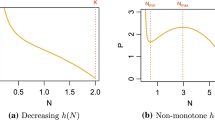Abstract
Mathematical models of predator-prey systems in which the prey species has a three-stage life cycle are studied. Certain stages of the prey life history are allowed to use younger stages as food. It is shown that sufficiently restricted cannibalism can result in an increase in the numbers of adult prey on a sustained basis when cannibalism decreases the vulnerability of a stage subject to predation or increases overall productivity.
Similar content being viewed by others
Literature
Coppel, W. A.. 1965.Stability and Asymptotic Behavior of Differential Equations. Boston: D. C. Heath and Company.
Landahl, H. D. 1955a. “A mathematical model for the temporal pattern of a population structure, with particular reference to the flour beetle”.Bull. Math. Biophys.,17, 63–77.
—. 1955b. “A mathematical model for the temporal pattern of a population structure, with particular reference to the flour beetle: II. Competition between species”.Bull. Math. Biophys.,17, 131–140.
— and B. D. Hansen. 1975. “A three stage population model with cannibalism”.Bull. Math. Biol.,37, 11–17.
Pielou, E. C. 1969.An Introduction to Mathematical Ecology. New York: Wiley.
Author information
Authors and Affiliations
Rights and permissions
About this article
Cite this article
Bobisud, L.E. Cannibalism as an evolutionary strategy. Bltn Mathcal Biology 38, 359–368 (1976). https://doi.org/10.1007/BF02462211
Received:
Revised:
Issue Date:
DOI: https://doi.org/10.1007/BF02462211




